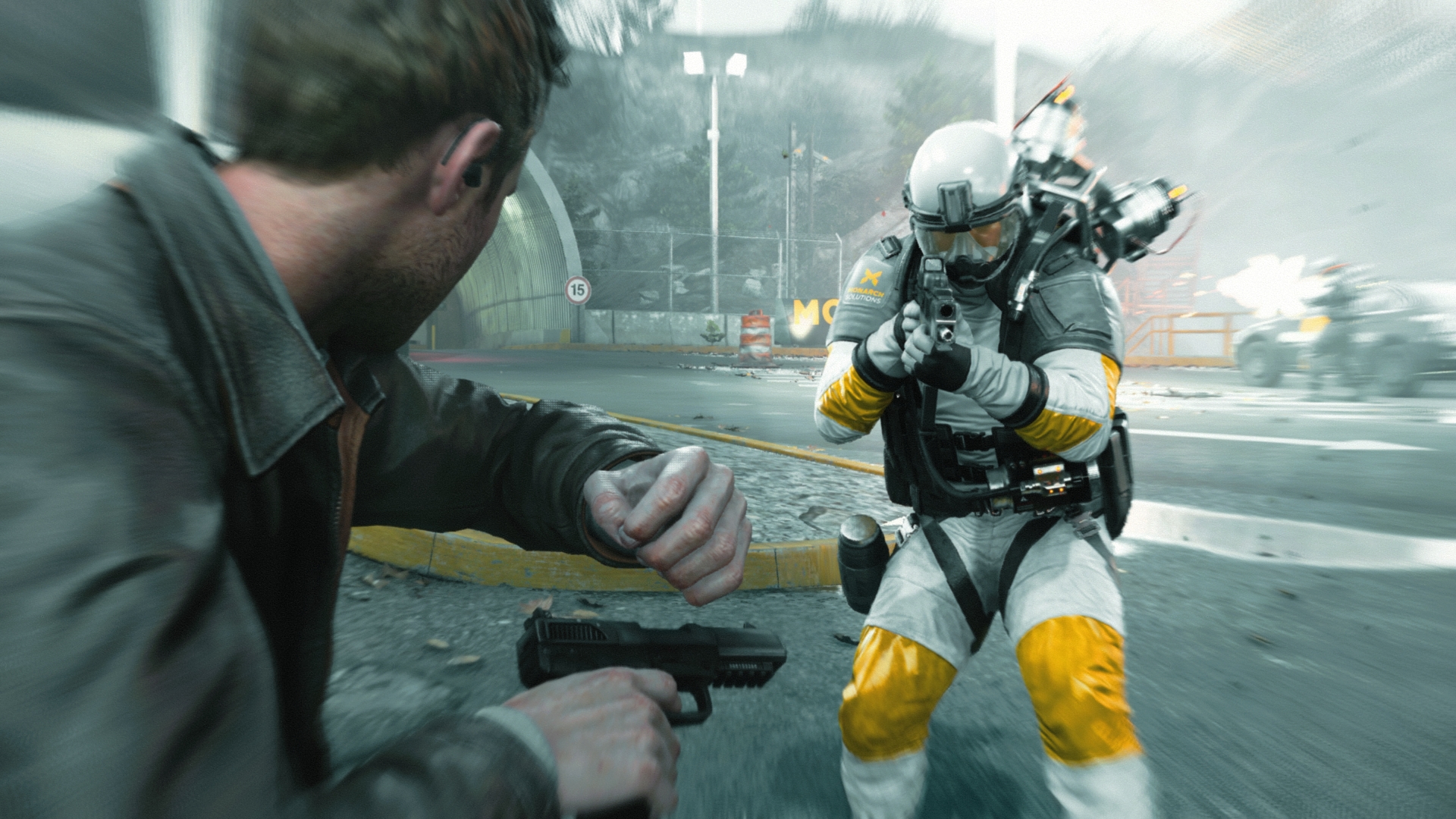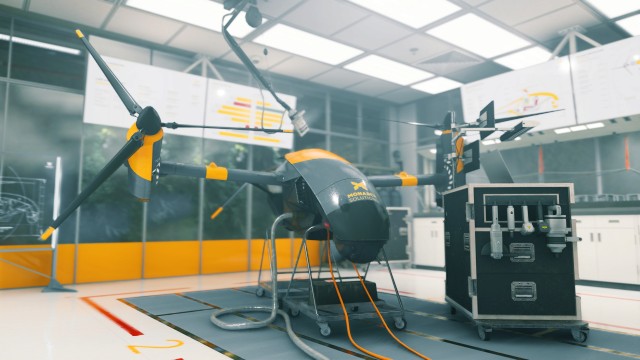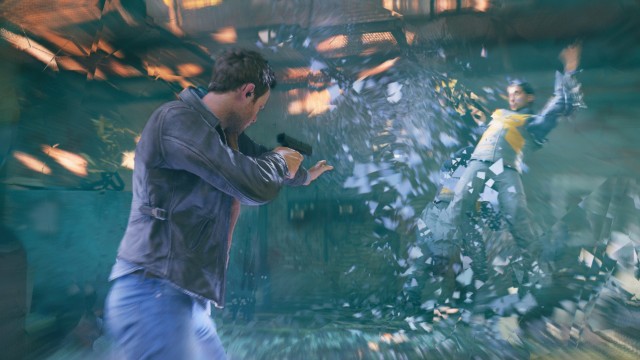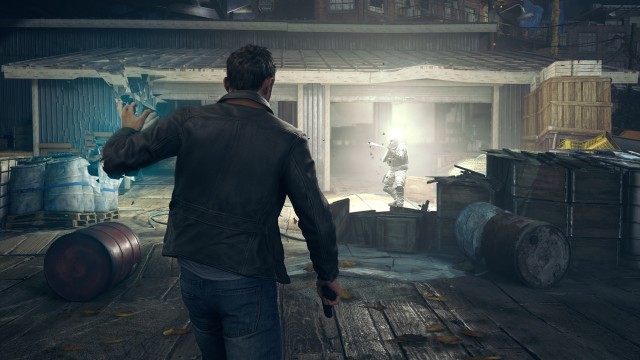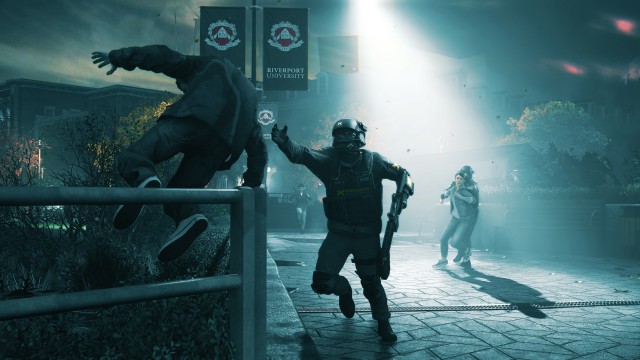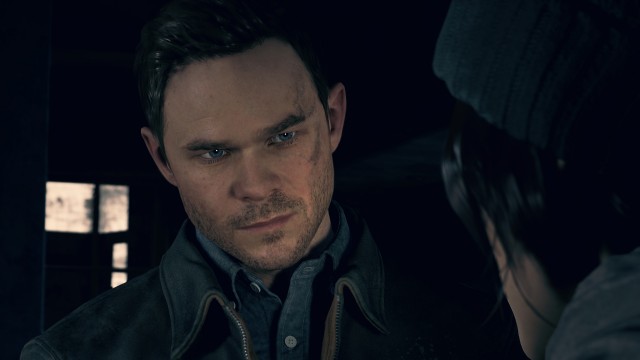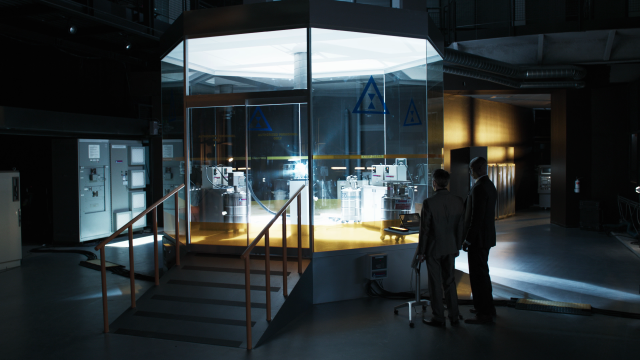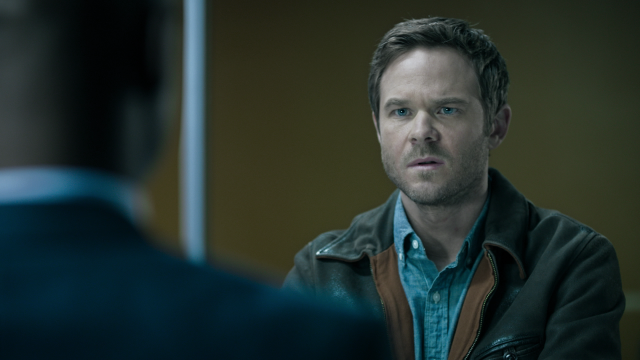Time travel has long been a cliché in science fiction movies, books, and video games. Quantum Break doesn’t exactly aim to change that, but Remedy Entertainment manages to handle the concept of time manipulation in perhaps the most coherent way it’s ever been done.
In Quantum Break, you play as Jack Joyce, the brother of insanely smart Will Joyce, an engineer who has somehow managed to create a device that let’s people travel forward or backward through time. Perhaps the part of the game that is cliché is that there is a massive accident at the outset that causes Jack to have various time powers, while Paul Serene, the CEO of Monarch Corporation–a company you’ll love to hate–is also caught in the experiment gone wrong. Unlike Jack, however, he decides to, of course, use his newly-crafted time powers for evil.
The beginning of the game revolves around finding Will to see how to fix the time problem, but once that is sorted, the game goes off in a few other directions which we’ll be careful not to spoil.
The entire thing is farfetched, but it lays the groundwork for a game that is otherwise fantastic. Suspend disbelief and let the game draw you into its world, and the City of Riverport becomes an intensely interesting, albeit eerie, setting.
Quantum Break is a showpiece for Xbox One. Remedy Entertainment has never been lazy in their execution of cutting edge visuals and production, and their latest title is absolutely no exception.
Characters are modelled after their real-world counterparts–Quantum Break is part video game, part live-action television show–and there is little separating the human characters from their virtual doppelgängers. Never before have we been able to move from live-action into the virtual space with such fluidity, and while it isn’t perfect, there is only a slight jar between the two segments of the game, making the transition smooth and effective.
Using some creative techniques to blend the virtual world with the real one, Remedy utilizes a custom film-like filter over the player experience. There’s a hazy blur throughout the game that seems out of place early on due to a lack of time travel–and therefore special effects–but becomes much more welcome later on when Jack gets into a time-aided firefight with a half dozen enemies.
With a mechanic like time travel and, perhaps more importantly, time manipulation, there technically wouldn’t exist any visual representation if everything were stopped. In order to make the game much more visually impactful, Remedy chose to utilize a style that makes it seem like time is “breaking down” around the player, a phrase used often throughout the experience. It is wonderful and perfectly effective; time really does seem like it is “breaking down,” with glass-like shards of the scene playing out in a very unique fashion.
With the intense amount of effects on screen at once, there is an occasional lower-resolution texture or jarring dip in framerate, though nothing so frequent that it alters the experience. The Xbox One is a very capable machine, but it does seem like Quantum Break pushes it in some areas.
It is a difficult thing to make time travel interesting. Sure, the concept is incredibly cool, but making it visually and phonically intriguing can be a challenge. The team at Remedy brilliantly turned to a lack of sound in many areas to make it seem like time had been truly stopped.
One of Jack’s powers allows him to stop time in waves and bubbles; rather than a massive explosion, sound is drawn away from the area, making for an incredibly science fiction take on time travel. Somehow, it is also one that feels realistic, if that is even possible.
There are some very creative sequences through which stories are told in Quantum Break. The player walks through a room and, while still having control, seems a scene play out in front of him. In some cases, it is the shadows of people who were there moments ago, while in others, it is an entire sequence in which months go by, allowing Jack to see just how events unfolded in that space. The sound through these sequences is equally as impressive as the visual imagery, and despite having little for the player to do other than watch them, are perhaps some of the most cohesive storytelling elements through the entirety of the experience.
Remedy Entertainment has often succeeded at being unique in its game design. However, this title in their portfolio is perhaps most unique in a very different way. It may be surprising to understand that Quantum Break is, in addition to being a great third-person shooter, an intriguing puzzle game in many ways.
With Jack’s abilities to manipulate time, there are often objects that can be frozen or altered from their current states in order to allow him to reach a new area or get out of a predicament. In one area, Jack stops time to prevent a scissor lift from falling, enabling him to reach a higher ledge. In another, Jack reverses time to revert a scaffold that had fallen over, also allowing him to traverse the environment in a different way.
These moments are sometimes more obvious than others, but perhaps most enjoyably, they’re never a chore to discover. A few times in the experience, for example, Jack stops time to keep a door open for an extra second or two, allowing him to slip by, but it is never too much to make it feel overused. If anything, it is just less than enough, making the player feel like a total badass when they pull it off every time. It is also especially rewarding when you stop time in the nick of time, preventing a car from flipping over onto you mid-sequence.
On occasion, players will control Paul Serene, Jack’s friend-turned-enemy who has decided to use his riches, authority, and newly-obtained time-bending powers (try saying that five times) for evil rather than good. These moments are called junction points, and happen five times throughout the Quantum Break experience. The choices a player makes during these moments drive the direction of the live-action sequences at the end of each act (of which there are also five), and allow the player to leave the hero’s mind for a moment while they contemplate what a time-wielding maniac might do.
While the game is built around what seems to be flexibility in choice, however, it seems to be more of an illusion than anything. For example, there are two possibilities in each junction point, of which the player gets a glimpse at each, then decides which way they will steer Serene. The live-action sequence following that junction point is based on the decision, which provides what seems to be a very clear-cut, “here is a choice you can make” element.
Beyond the A or B selection, there is no organic way for the player to feel like they’re actually influencing the story of Quantum Break. Gameplay is linear and worlds tend to be repetitive–an empty warehouse, a lonely corridor, a community pool–these are all common themes that play out over and over again in Remedy’s title. The player is fuelled into following a very specific sequence of events centred around the story that the developer wants to tell, despite being guised as a “choose your own adventure” game.
With that said, these junction points do offer a bit of a break from the linear story by virtue of being able to control the opposing character. There are also some neat social components whereby players will see which choice their friends made (based on their Xbox friends list) as well as what the rest of the community chose at that point in the game. It’s a great way to make you feel like a real jerk if you chose the route that harms or perhaps kills people while the majority of your friends opted to save them.
Other pieces of the Quantum Break experience are not so intriguing, unfortunately. There is little enemy variety in the first half of the game, and even in the latter hours of this eight to ten hour experience (not including the live-action scenes), new enemy types quickly became stale. There is little reason to collect any different weapons because they all feel virtually identical, despite there being three different assault rifles, two pistols, and a shotgun to choose from. Sure, the shotgun felt heavier at close range while the automatic weapons were more effective from a distance, but there was little difference otherwise.
Remedy Entertainment has long touted their abilities as storytellers, and Quantum Break upholds their reputation. The game even launches with a logo for the developer’s storytelling engine, Northlight. It’s difficult to pinpoint exactly what makes the story so enjoyable because it is centred around such an overused concept in science fiction.
There’s a lot done to explain time travel in a very simple way using a loop, going as far as having the time machine in the game be an actual, physical tunnel forming a loop. There a couple of holes in the narrative here and there, especially when the end of the game gets into the idea of travelling back in time, undoing something that changes the future, returning to the present, seeing that it has already happened anyway, returning to the past again, and so on. It gets a bit convoluted, which is perhaps the best way to sell that time travel wouldn’t be a great idea in practice.
Writing is well-done, and collectibles throughout the universe that expand the story are some of the most intricate and detailed we’ve ever seen. There are more than a few computers to search and collect emails from, some of which can be pieced together to form an extended backstory for who would otherwise be a couple of inconsequential characters.
Near the end of the game, the experience does fall apart a bit if only because of a cryptic, lacklustre ending. There is such a wonderful build up between Jack and Paul, but it falls flat in the final minutes of the game. The credits roll, and there is a post-credits sequence that sets up a sequel while also wrapping things up, though anything is up in the air when time travel is concerned.
It’s difficult to say that Quantum Break actually has a television show as part of its experience. Remedy has simply included live-action, 22-minute cutscenes between key acts of the game and decided to call it a television show alongside its game. The scenes wouldn’t be very coherent without the game to fill in the gaps, though it would probably make some sense.
Production on the show is quite a bit higher than one might expect from a video game, but is certainly not up to the par of primetime television. There are little bits of polish here and there, but the whole thing seems to be underproduced. Like a pilot that might make it to primetime for a season and get discontinued after an eight-episode run.
It helps that the show has some heavyweight actors such as Shawn Ashmore (X-Men) and Aiden Gillen (Game of Thrones) as well as Dominic Monaghan (Lord of the Rings) and Lance Reddick (Fringe). Each plays their role exceptionally well and are believable as the characters they’re cast in, though it would have been nice to see Reddick try a different role than his usual stern self.
Quantum Break is a great diversion from the traditional gameplay loop. The addition of a television show throughout the experience is interesting and effective, even if the show isn’t as well-produced as it could be. There are some odd design choices–putting the achievement for the end of an act before the cutscene rolls through lets the player know they’re through with that portion of the game does well to take the player out of the experience–and painfully long load times between some cutscenes, not to mention buffering issues with the live-action show.
With that said, Remedy has managed to craft an otherwise entertaining experience that plays out very much like a Michael Bay film: grand in scope and scale, full of action and intense sequences, but a bit of a miss in the execution department.

